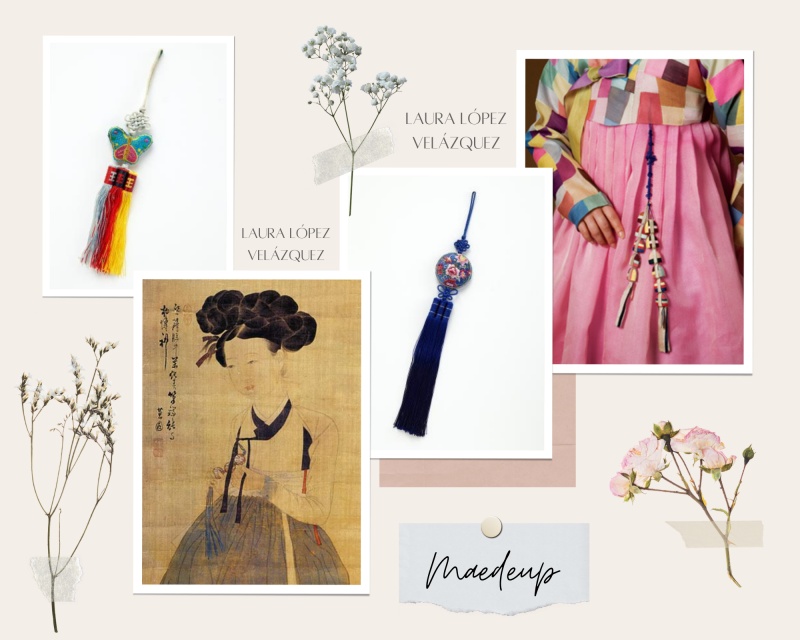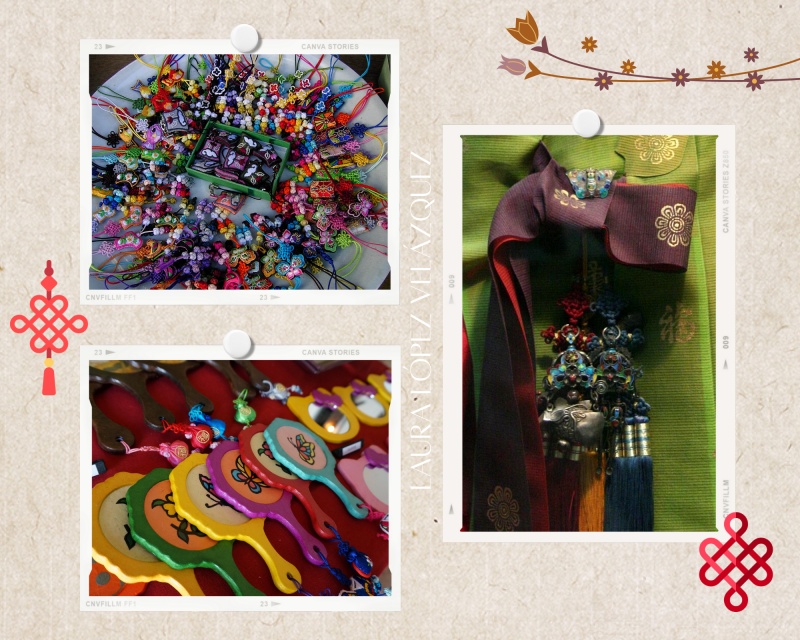- 한국어
- English
- 日本語
- 中文
- العربية
- Español
- Français
- Deutsch
- Pусский
- Tiếng Việt
- Indonesian
By Honorary Reporter Laura Lopez Velazquez from Mexico
Photo = Laura Lopez Velazquez

The traditional craft of maedeup is used in a variety of objects like norigae, a pendant attached to silk strings and worn on the high waist of a Hanbok skirt, and mirrors. (Laura Lopez Velazquez)
The traditional Korean craft of decorative knotting is maedeup, which is derived from the early practice of using knots in fishing nets and agricultural tools. The art of decorative knotting, maedeupjang, is designated National Intangible Cultural Heritage No. 22 by the Korean government.
Korean knots are unique in the braiding techniques used. A variety of knots can be made with one or two threads and possess bilateral symmetry with a tassel (sul) at the bottom of the knot. Knots elsewhere in East Asia are usually flat or pattern based. For example, Chinese knots are letter shaped and Japanese knots are looser, while Korean knots are extremely tight and three dimensional. In knotting style and dyeing, Korea was influenced by China and later did the same to Japan. Compared with the more elegant knots of China, maedeup shows a simple but elegant beauty.
History
Maedeup dates back to the Three Kingdoms period (37 B.C.-A.D. 668). In the beginning, it was used around the waist to hold hunting and fishing tools such as stone axes and swords but evolved into a form of decorative art. Not just an ornament, it was also considered a talisman of peace and happiness. These knots were used in the royal court and decorations for Buddhist ceremonies, as well as being finishing touches to clothing, accessories, musical instruments, pockets and buttons.
Formal knots can be seen in Buddhist murals and paintings from the Goryeo Dynasty (918-1392) and in paintings and clay figures from the Joseon Dynasty (1392-1910). During the Joseon era, maedeup emerged as an element of high social status, and thus the royal court employed dozens of workers in this craft. At royal palaces, knots were considered a sign of dignity and prestige.
Elaboration
The charm of maedeup lies in its unique structure and clean knots, striking a balance between order and form. Its elaboration requires four stages: dyeing threads with natural pigments, making dahoe (braided string), tying knots and producing tassels. The most common materials used to tie knots are silk thread, ramie, mulberry, hemp and wool, with silk thread being the most used. Tassels also varied by type and level according to use like for the royal palace or home.

Maedeup are used in norigae (pendants) used to decorate Hanbok. (Laura Lopez Velazquez)
The shapes of knots vary depending on the color, thickness and methods used in tying. The names of knots differ by region and were mainly inspired by items from everyday life and nature like flowers and insects. Among the more than 30 types of traditional basic knots, the most common are dorae, the most basic knot, and maehwa, whose shape resembles an apricot blossom.
Several types of strings are also used to make decorative knots. The circular strings used in accessories or bags are dongdahoe, the wide and flat strings used in belts gwangdahoe, and those used in ceremonial clothing or accessories gyeokdap or gyeolja.
Maedeup is also commonly used in norigae, a decorative pendant used when wearing Hanbok (traditional Korean costumes). Knotting is a meticulous process so making a pendant takes three months.
Traditional knots are no longer used as much as in the past, but the craft is being passed on by the older generation. Maedeup has survived in the present day through adaptation to modern society and application to accessories, jewelry and home interior decoration.
enny0611@korea.kr
*This article is written by a Korea.net Honorary Reporter. Our group of Honorary Reporters are from all around the world, and they share with Korea.net their love and passion for all things Korean.